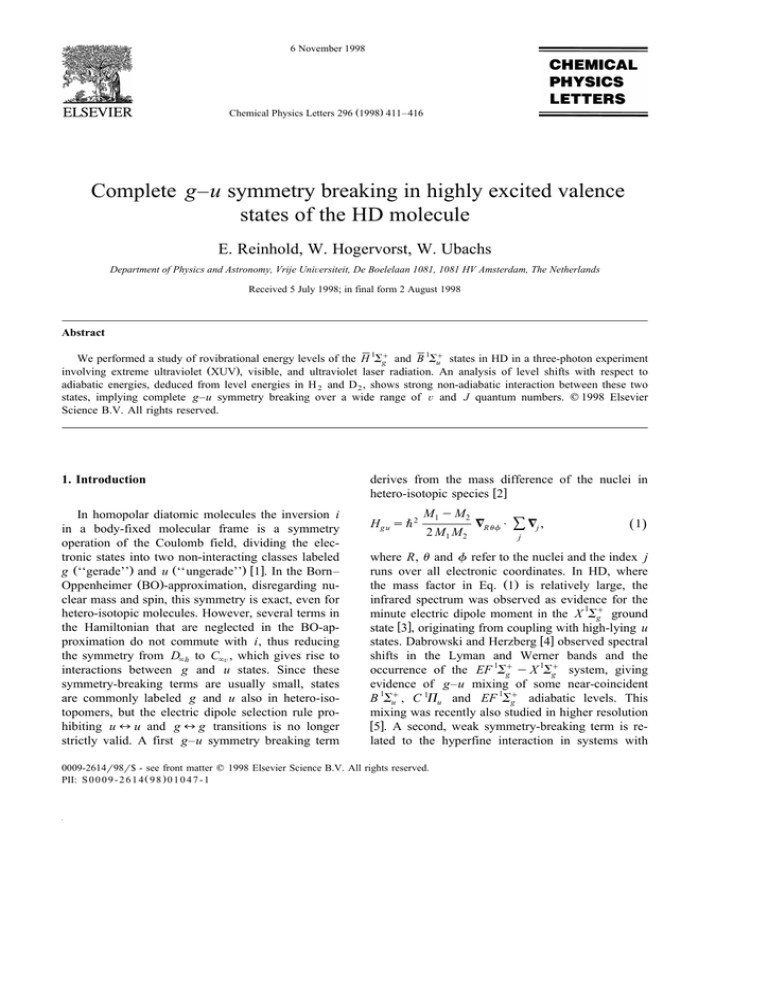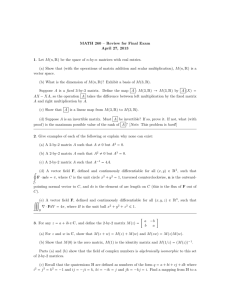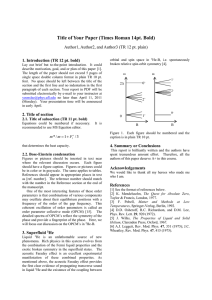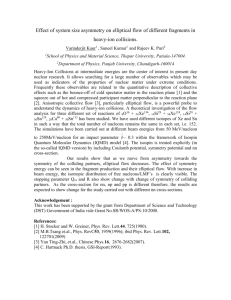g states of the HD molecule E. Reinhold, W. Hogervorst, W. Ubachs
advertisement

6 November 1998 Chemical Physics Letters 296 Ž1998. 411–416 Complete g–u symmetry breaking in highly excited valence states of the HD molecule E. Reinhold, W. Hogervorst, W. Ubachs Department of Physics and Astronomy, Vrije UniÕersiteit, De Boelelaan 1081, 1081 HV Amsterdam, The Netherlands Received 5 July 1998; in final form 2 August 1998 Abstract 1 q We performed a study of rovibrational energy levels of the H 1Sq g and B Su states in HD in a three-photon experiment involving extreme ultraviolet ŽXUV., visible, and ultraviolet laser radiation. An analysis of level shifts with respect to adiabatic energies, deduced from level energies in H 2 and D 2 , shows strong non-adiabatic interaction between these two states, implying complete g–u symmetry breaking over a wide range of Õ and J quantum numbers. q 1998 Elsevier Science B.V. All rights reserved. 1. Introduction In homopolar diatomic molecules the inversion i in a body-fixed molecular frame is a symmetry operation of the Coulomb field, dividing the electronic states into two non-interacting classes labeled g Ž‘‘gerade’’. and u Ž‘‘ungerade’’. w1x. In the Born– Oppenheimer ŽBO.-approximation, disregarding nuclear mass and spin, this symmetry is exact, even for hetero-isotopic molecules. However, several terms in the Hamiltonian that are neglected in the BO-approximation do not commute with i, thus reducing the symmetry from D`h to C`Õ , which gives rise to interactions between g and u states. Since these symmetry-breaking terms are usually small, states are commonly labeled g and u also in hetero-isotopomers, but the electric dipole selection rule prohibiting u l u and g l g transitions is no longer strictly valid. A first g–u symmetry breaking term derives from the mass difference of the nuclei in hetero-isotopic species w2x Hg u s " 2 M1 y M 2 2 M1 M 2 =R uf P Ý =j , Ž 1. j where R, u and f refer to the nuclei and the index j runs over all electronic coordinates. In HD, where the mass factor in Eq. Ž1. is relatively large, the infrared spectrum was observed as evidence for the minute electric dipole moment in the X 1Sq g ground state w3x, originating from coupling with high-lying u states. Dabrowski and Herzberg w4x observed spectral shifts in the Lyman and Werner bands and the 1 q occurrence of the EF 1Sq system, giving g y X Sg evidence of g–u mixing of some near-coincident 1 q 1 B 1Sq adiabatic levels. This u , C P u and EF S g mixing was recently also studied in higher resolution w5x. A second, weak symmetry-breaking term is related to the hyperfine interaction in systems with 0009-2614r98r$ - see front matter q 1998 Elsevier Science B.V. All rights reserved. PII: S 0 0 0 9 - 2 6 1 4 Ž 9 8 . 0 1 0 4 7 - 1 412 E. Reinhold et al.r Chemical Physics Letters 296 (1998) 411–416 nonzero nuclear spin. Its effect was studied in the I 2 w x and Cs 2 molecules w6,7x and in the Hq 2 ion 8 . In this Letter we present an example of complete wave function mixing between highly excited valence states of g and u symmetries in HD, i.e. we observed a state in which g and u wave function contributions are comparable over a wide range of Õ and J quantum numbers. The excitation energy of both states is ; 15 eV above the electronic ground state. The state of g symmetry corresponds to the outer part Ž H . of the double-well HH 1Sq g state in hydrogen, which was predicted in ab initio calculations by Wolniewicz and Dressler w9–11x. The state of u symmetry, called B 1Sq and built from the u same atomic orbital configurations, is also the outer part of a double-well BO-potential, of similar shape and minimum position, but with a higher internal barrier, as calculated by Kołos w12x. Fig. 1 shows the HH 1Sq and BXX B 1Sq Born–Oppenheimer poteng u tials, the former taken from a recent ab initio calculation w13x. The inset shows the small difference be- XX 1 q Fig. 1. Potential energy curves of the HH 1Sq g and B B Su states of hydrogen from ab initio calculations w12,13x. The ionization threshold is indicated. The inset gives the potentials in the range 9–13 a.u., showing that the B potential is lower at the bottom of the potential well. tween the H and B potentials near the bottom of the wells, while in the range of R ) 13 a.u. the potentials coincide within a few cmy1 . While the B states were hitherto unobserved, the first observation of bound levels of the H state in H 2 was recently reported by our group w14x. 2. Experiment We report on observations of more than 100 rovibrational states of HD localized in the H 1Sq g and B 1Sq u outer potential wells. Experimentally these states are excited and probed using a three-laser setup described earlier w14x. A tunable extreme ultraviolet ŽXUV. laser source in the range 91–93 nm, based on nonlinear frequency upconversion of a Nd:YAG pumped dye laser, first excites high-Õ levels of B 1Sq u of HD. A second tunable laser in the range 554–676 nm further excites the hydrogen molecules into the outer well states, using the Franck–Condon overlap at the outer turning point of the B 1Sq u wave function at R ; 8 a.u.. A third laser at 355 nm is used to dissociatively ionize the hydrogen and produce Hq and Dq ions that are monitored for signal. Time-of-flight mass-separation is applied for independent detection of HDq, Hq, and Dq ions. As a consequence of g–u symmetry breaking, all outer-well states in HD can decay by fluorescence in the XUV, limiting their lifetime to ; 1 ns; therefore all three laser pulses, of 3–5 ns duration, are temporally overlapped in the interaction region. Excited states are identified as J s 0–3 of H, Õ s 4–17 and B, Õ s 9–21. Level energies are determined with an average uncertainty of 0.05 cmy1 , 1 q calibrating the B 1Sq u y X S g transitions in the XUV to the accurately known XUV transition frequencies in H 2 w15x and the frequency of the second laser to the absorption spectrum of I 2 . Different intermediate levels are used to check combination differences. The spectrum of Fig. 2 consists of separate scans of the second laser, with the XUV laser tuned on different intermediate states of HD, using favorable Franck–Condon overlap with the upper state. Close to the predicted energies of adiabatic H vibrational levels in HD w10x, two series of doublets of almost equal spacing are found, belonging to P and R transitions exciting H and B rovibrational levels. E. Reinhold et al.r Chemical Physics Letters 296 (1998) 411–416 413 13, J s 0–5. and 84 levels in D 2 Ž Õ s 6–19, J s 0– 5. are measured in the same way as in HD, with an average experimental accuracy of 0.05 cmy1 w16x. Rovibrational level energies of each isotope can be expressed by a Dunham expansion w17x: E Ž Õ, J . s Ý Yk l Ž Õ q 12 . k l J Ž J q 1. . Ž 2. k ,l Fig. 2. Observed spectrum of vibrational sequences in the H 1Sq g 1 q 1 q y B 1Sq u and B Su y B Su systems in HD, with assignments as indicated. The lower trace is composed from pieces of spectrum taken with different intermediate J s 2 states, chosen for favorable Franck–Condon factors. Since both systems involve a 1Sq y 1 q S transition a P Ž2. and an RŽ2. line are observed for each band. The upper spectrum shows the H y B Ž17,21. and B y B Ž17,21. lines. Note the increased linewidth in the H y B band, indicating a short lifetime due to autoionization. Comparison of the intensities of the transitions to Õ s 15–17 upper levels, all excited via the B 1Sq u , Õ s 21, J s 2 state, immediately and straightforwardly conveys the message of the present study: B levels, supposedly of u symmetry, are equally well excited as H levels of g symmetry, indicating the complete breakdown of g–u symmetry for these states in HD. 3. Results and discussion The effects of the strong nonadiabatic g–u coupling in HD can be extracted from a comparison of experimental level energies with calculated H energies of a hypothetical homonuclear isotopomer with the same nuclear reduced mass as HD. These are obtained from a Dunham analysis of experimental energy levels in H 2 and D 2 , where g–u coupling is absent. Energy positions of 72 levels in H 2 Ž Õ s 2– In a vibrating rotator model, with an arbitrary but isotope-independent potential and with a rotational constant Be and a harmonic frequency ve at the classical equilibrium, the coefficients Yk l are given as power series in Be2rv e2 . This results in relations between Yk l values for different isotopes, the leading term scaling as myŽ k r2ql . and the first order correction term as myŽ k r2qlq1., with m the reduced mass of nuclear motion. Y00 forms an exception because the leading term would be a mass-independent constant, vanishing by an appropriate choice of the energy scale. In an integrated fitting procedure for H 2 and D 2 the Dunham model is applied in a slightly modified way, because the assumption of an isotope-independent potential is not fully adequate. Instead we assume the potential to consist of a dominant, isotopeindependent part Žwhich can be identified with a Born–Oppenheimer potential. and a small correction potential, which scales with my1 like the terms in the molecular Hamiltonian that are responsible for the adiabatic shift w10x. This results in contributions to each Yk l that scale with an extra factor of my1 compared to the terms belonging to the mass-independent potential; thus the leading term in Dunham’s relations of the Yk l remains unaffected, whereas an extra contribution appears in the first order correction term. A further minor modification is induced by allowing for an arbitrary zero point of the energy scale instead of fixing it to the potential minimum; this leads to a mass independent offset in Y00 , which we call Te . All terms of second order or higher in Be2rv e2 are neglected. For all parameters but Y00 and Y01 the first order correction term is also neglected so that the Yk l for D 2 can be fixed to H 2 values by Yk l Ž D 2 . s Yk l Ž H 2 . mŽH2 . m Ž D2 . k ql 2 . Ž 3. E. Reinhold et al.r Chemical Physics Letters 296 (1998) 411–416 414 Y00 and Y01 are split into two fit parameters: one part scaling according to Eq. Ž3., corresponding to Te Žmass invariant. and Be respectively, and a second part d k l scaling with myŽ k r2qlq1.. A requirement for fitting all energies to a single expansion is that the levels in H 2 and D 2 are brought to the same energy scale, while they are experimentally determined relative to their respective ground states. This is achieved by subtracting 689.98 cmy1 from the D 2 level energies, the energy difference of the X 1Sq g , Õ s 0, J s 0 ground state in H 2 and D 2 with respect to two positive ions at infinite separation, using the best available dissociation energies of H 2 and D 2 and ionization energies of H and D w18x. As result of the fit, the entire set of experimental data of the H state in H 2 Ž Õ s 2–13, J s 0–5. and D 2 Ž Õ s 6–19, J s 0–5. is reproduced, with a standard deviation of s - 0.1 cmy1 , by a set of 13 parameters listed in Table 1. The small value of Be2rve2 f 7 = 10y6 Žtaking ve f Y10 . gives numerical justification for neglecting the higher-order terms in the reduced-mass scaling. A further interpretation of some parameters is instructive: Subtracting the value of Te from the total binding energy of the ground state in H 2 gives a potential depth of y132847.86 cmy1 or y0.6052994 a.u. for the H BO potential, 0.58 cmy1 less than the best ab initio value w13x. The contribution to d 00 originating from the mass-independent part of the potential, given by Dunham’s expression for Y00 , can be related to the values of Y01 , Y10 , Y11 and Y20 and thereby separated from the adiabatic shift; we get a value of y1.22 cmy1 for H 2 , which leads to an overall adiabatic shift of 78.28 cmy1 , close to the ab initio value of Table 1 Dunham parameters representing the H 1Sq g state of H 2 and D 2 , with appropriate mass-scaling, used for calculating level energies in HD without g – u coupling. Y02 is fixed to a value given by theoretical relations to other coefficients. Individual uncertainties cannot be given due to strong correlations. All values in cmy1 Te d 00 Y10 Y20 Y30 Y40 Y50 122627.75 77.06 360.76 y5.0503 3.8914=10y2 7.9663=10y5 y3.5285=10y5 Be d 01 Y11 Y21 Y31 Y02 0.95770 y3.9204=10y3 8.6621=10y3 y1.4030=10y3 7.1327=10y5 y2.7000=10y5 Fig. 3. Energy shifts of observed H Žv . and B Ž`. J s 0 levels in HD with respect to adiabatic H, Õ, J s 0 levels, determined from the H 2 and D 2 data using a Dunham analysis. The upper part shows the mixing fraction b 2 of u symmetry in the H state for each Õ. 79.55 cmy1 at the potential minimum w13x. H energies for the hypothetical homonuclear equivalent of HD then follow from the Dunham coefficients by scaling with the reduced mass of HD and adding 317.56 cmy1 for the ground state energy offset. Strikingly this leads to strong deviations between the calculated and the experimental H energies. These must be attributed to nonadiabatic interactions, with the g–u coupling with the B state the only candidate. The deviations are displayed in the lower part of Fig. 3 for all observed J s 0 levels in the energy range where both states were detected, showing a strong avoided-crossing character; a similar picture arises for J s 1–3. For a deperturbation analysis to be complete, interactions between all levels of the same J must be considered. However, in a first approximation only interactions between neighbouring vibrational states are analyzed, subsequent states lying typically ten times farther away. The interaction matrix elements Wg u as well as the mixing coefficients of the H and B states can then be quantified by considering the E. Reinhold et al.r Chemical Physics Letters 296 (1998) 411–416 eigenvalue problem for each set of Õ and J separately: ž EH Wg u Wg u EB / C s EC Ž 4. : < 1 q: with C s a < H 1Sq g q b B Su . The two eigenvalues E1,2 are identified with the energies of the observed levels and the ‘unperturbed’ H energy EH is assumed to be the energy calculated with the Dunham coefficients; this determines the problem without an input for the ‘unperturbed’ B energy. The resulting values of b 2 are displayed in the upper part of Fig. 3, illustrating the strong g–u mixing in a large number of rovibrational states. Surprisingly, the interaction matrix element Wg u equals 14.1 " 0.1 cmy1 in all cases with Õ s 9–16, J s 0–3. For Õ s 17 we get f 15.5 cmy1 , but its energy is about 300 cmy1 above the highest levels in H 2 and D 2 from which the Dunham coefficients are derived. In addition interactions with states in the inner potential well are no more negligible. In fact this is the highest vibrational level predicted by Wolniewicz and Dressler w10x to be confined in the outer well of the HH potential in the case of HD; therefore tunneling through the top of the potential barrier should be strong, opening the pathway to autoionization. The latter is confirmed by the observation of a strong HDq-parent ion signal, combined with a line broadening to 1–2 cmy1 as shown in Fig. 2. For the the B state vibrational levels Õ s 9–21 were observed, with the highest level, Õ s 21, J s 3 at 128476.9 cmy1 and a linewidth of about 2 cmy1 . Due to the higher barrier in B, higher vibrational states than in H remain localized within the outer well; autoionization is possible either by tunneling through the barrier or by coupling to g states lying above the barrier of the HH potential. 415 HD was observed w4,5x between the EF 1Sq g state 1 q and the B 1Sq and C P states, but in that case the u u effect of the interaction is weak due to large level spacings, except for some accidental coincidences. In the case of the H and B states the potentials are of similar shape and origin, while the B state has a slightly lower minimum and a somewhat steeper slope at R s 6–8 a.u. Žcf. Fig. 1., giving rise to a crossing of the almost equidistant vibrational ladders near Õ s 14. Due to the shallow potential minima, vibrational spacings are nearly an order of magnitude smaller than in other states of hydrogen, causing the interaction to show up strongly in a large number of near-coincident states. Moreover, vibrational levels that lie close have the same quantum number Õ, which implies that the g–u interaction Hamiltonian is governed by diagonal Ž DÕ s 0. vibrational overlap matrix elements. The fact that the matrix element is constant over a large range of Õ and J suggests that the g–u interaction varies weakly with internuclear distance. The present experimental findings are supported and quantitatively explained by a semi-empirical analysis using Dunham’s formalism and a comparison between H 2 , D 2 and HD. Future ab initio calculations of the perturbing Hamiltonian of Eq. Ž1. may reveal more details about the non-adiabatic g–u coupling, in particular the dependence of the coupling parameter on the internuclear distance. Acknowledgements The authors wish to thank L. Wolniewicz for making available his ab initio calculations on the HH state prior to publication and acknowledge the Vrije Universiteit for a USF-project grant. References 4. Conclusion In conclusion we find a strong coupling between states of g and u symmetries in HD over an extended energy range. Previously g–u coupling in w1x P.R. Bunker, Molecular Symmetry and Spectroscopy, Academic Press, New York, 1979. w2x P.R. Bunker, J. Mol. Spectrosc. 46 Ž1973. 119. w3x R.A. Durie, G. Herzberg, Can. J. Phys. 38 Ž1960. 806. w4x I. Dabrowski, G. Herzberg, Can. J. Phys. 54 Ž1976. 525. w5x P.C. Hinnen, S. Werners, S. Stolte, W. Hogervorst, W. Ubachs, Phys. Rev. A 52 Ž1995. 4425. 416 E. Reinhold et al.r Chemical Physics Letters 296 (1998) 411–416 w6x J.P. Pique, F. Hartmann, R. Bacis, S. Churassy, J.B. Koffend, Phys. Rev. Lett. 52 Ž1984. 267; J.P. Pique, F. Hartmann, S. Churassy, R. Bacis, J. Phys. ŽParis. 47 Ž1986. 1917. w7x H. Weickenmeier, U. Diemer, W. Demtroder, M. Boyer, ¨ Chem. Phys. Lett. 124 Ž1986. 470. w8x R.E. Moss, Chem. Phys. Lett. 206 Ž1993. 83. w9x L. Wolniewicz, K. Dressler, J. Mol. Spectr. 77 Ž1979. 286. w10x L. Wolniewicz, K. Dressler, J. Chem. Phys. 82 Ž1985. 3292. w11x L. Wolniewicz, K. Dressler, J. Chem. Phys. 100 Ž1994. 444. w12x W. Kołos, J. Mol. Spectrosc. 62 Ž1976. 429. w13x L. Wolniewicz, J. Chem. Phys. 108 Ž1998. 1499. w14x E. Reinhold, W. Hogervorst, W. Ubachs, Phys. Rev. Lett. 78 Ž1997. 2543. w15x P.C. Hinnen, W. Hogervorst, S. Stolte, W. Ubachs, Can. J. Phys. 72 Ž1994. 1032; E. Reinhold, W. Hogervorst, W. Ubachs, J. Mol. Spectrosc. 180 Ž1996. 156. w16x E. Reinhold, W. Ubachs, W. Hogervorst, L. Wolniewicz, to be published. w17x J.L. Dunham, Phys. Rev. 41 Ž1932. 721. w18x L. Wolniewicz, J. Chem. Phys. 103 Ž1995. 1792.




